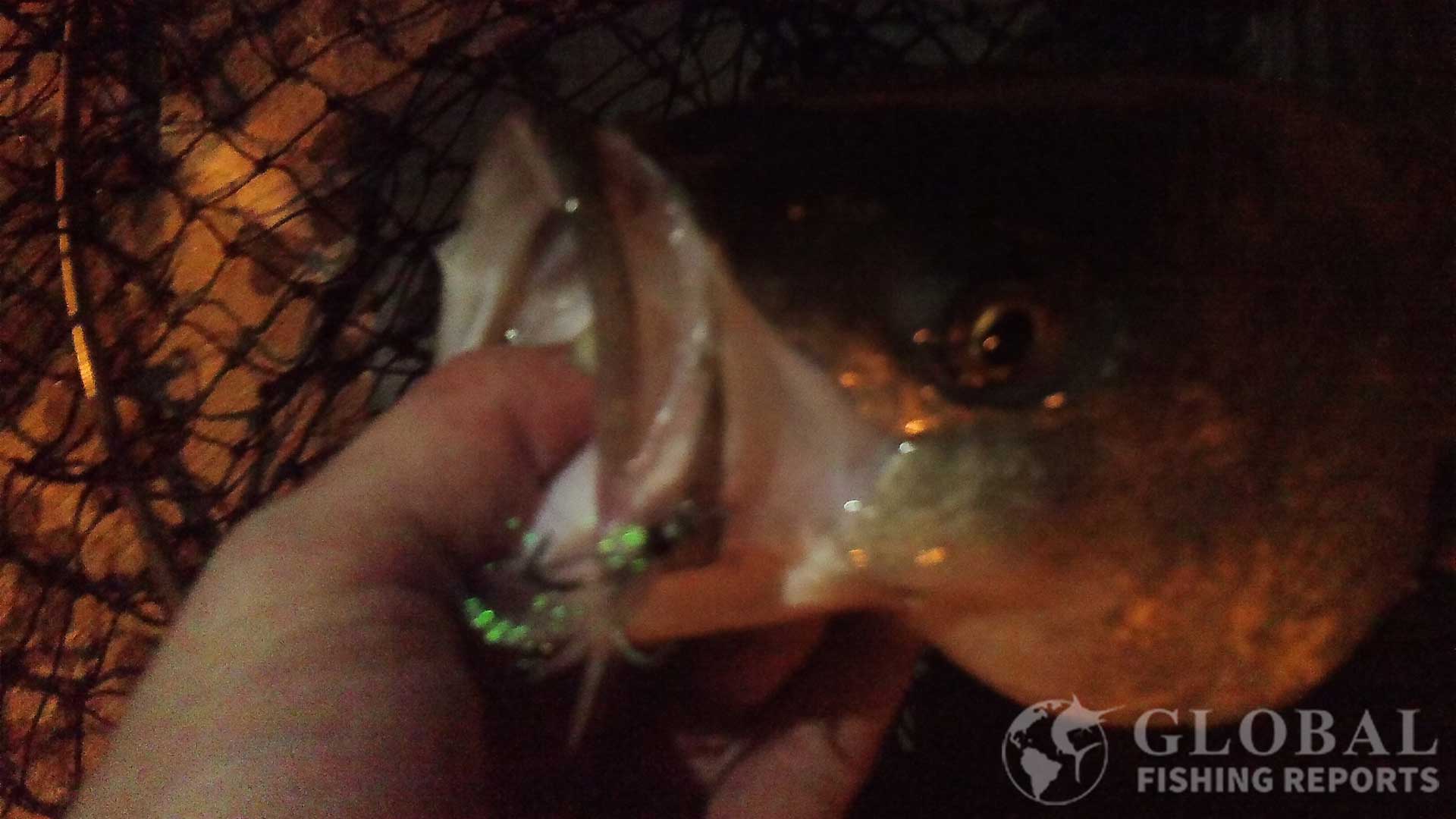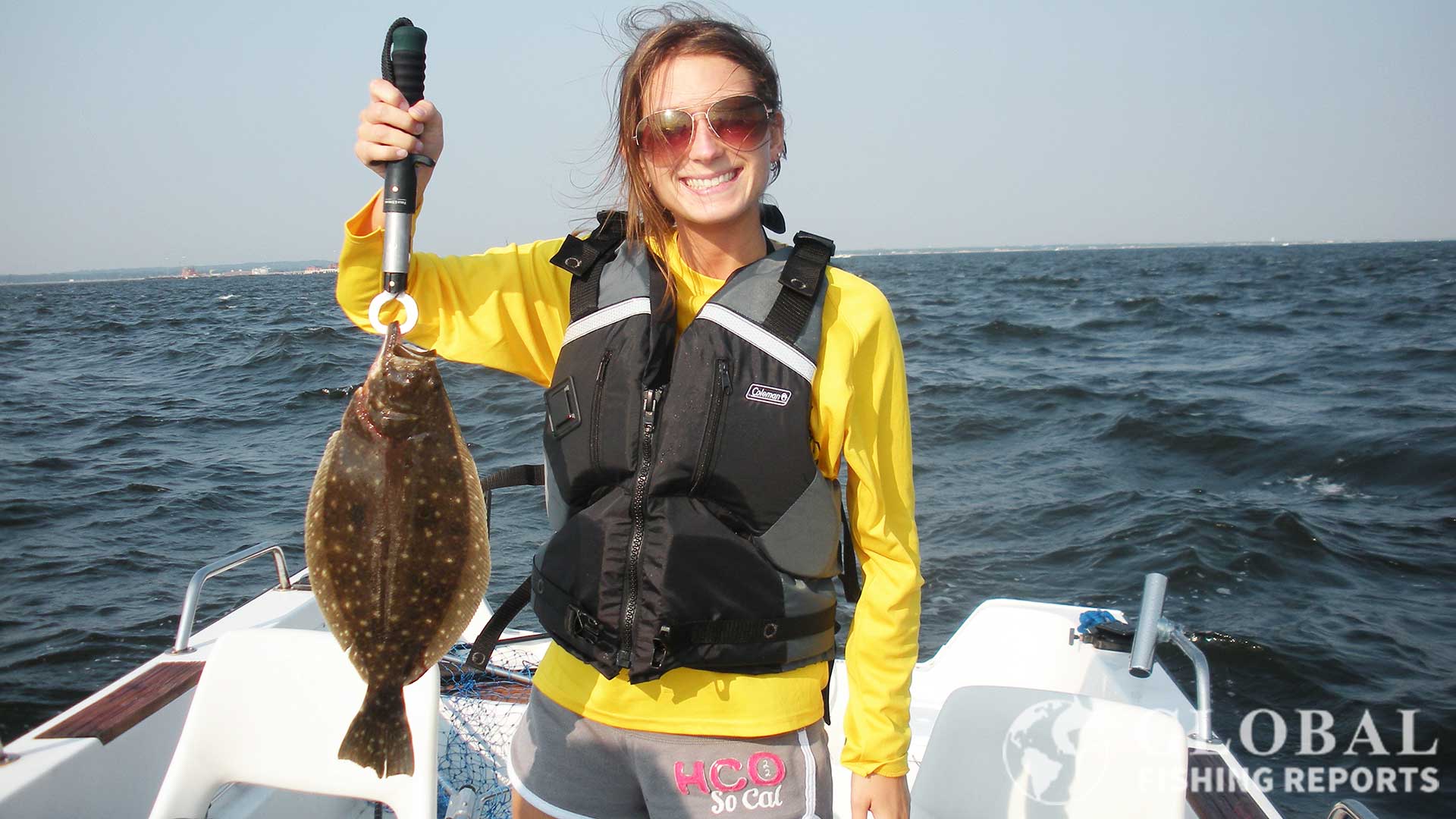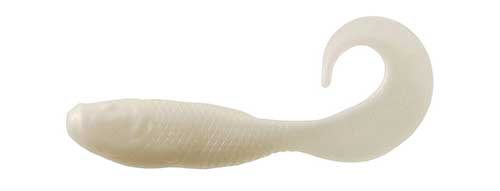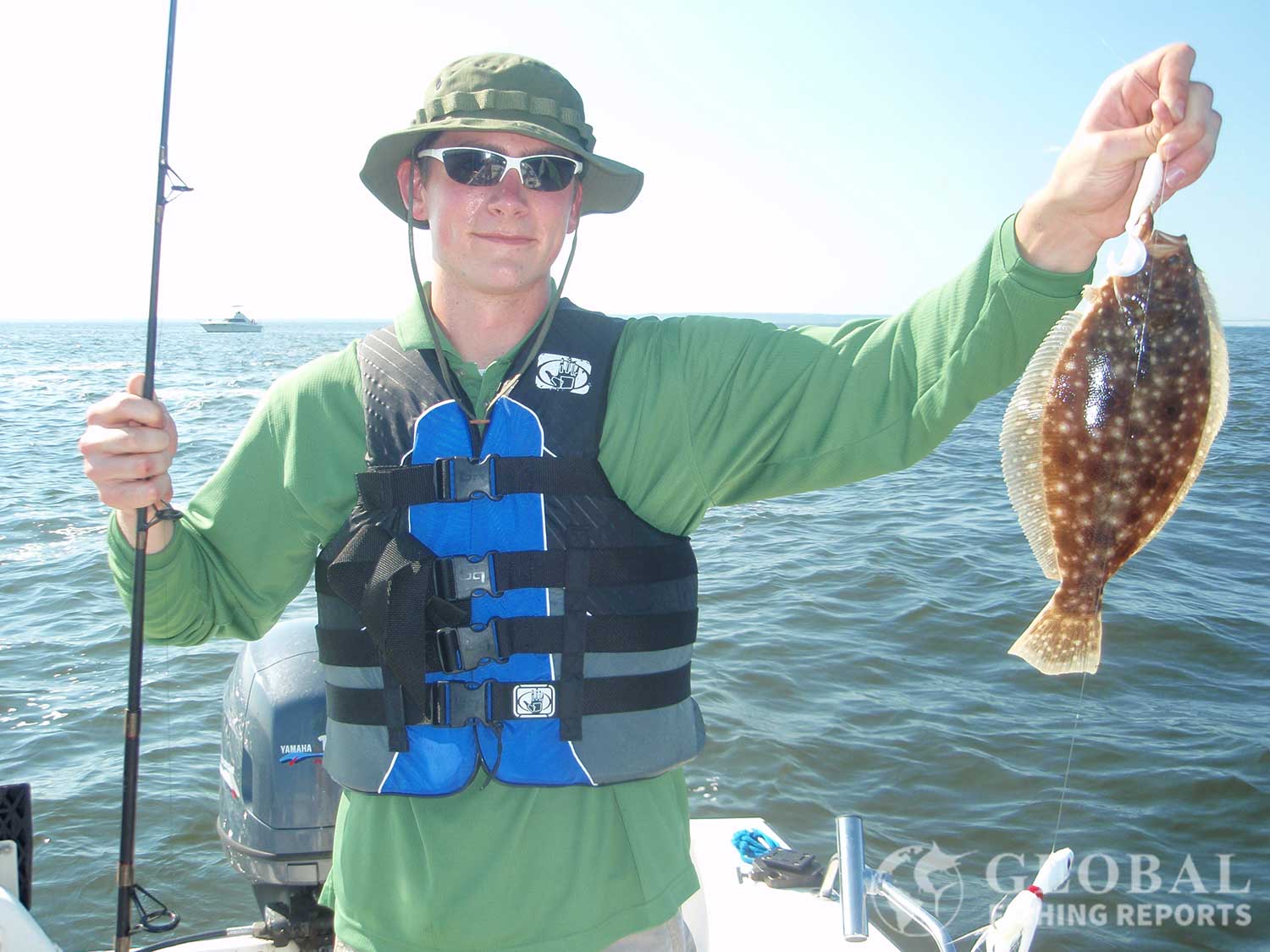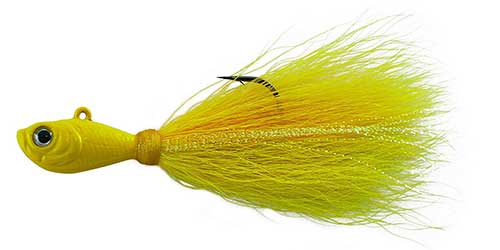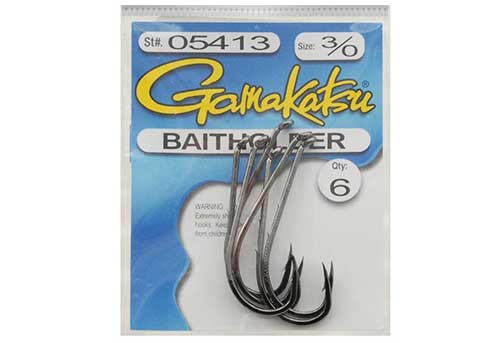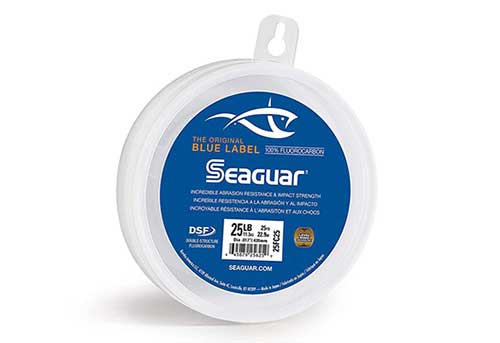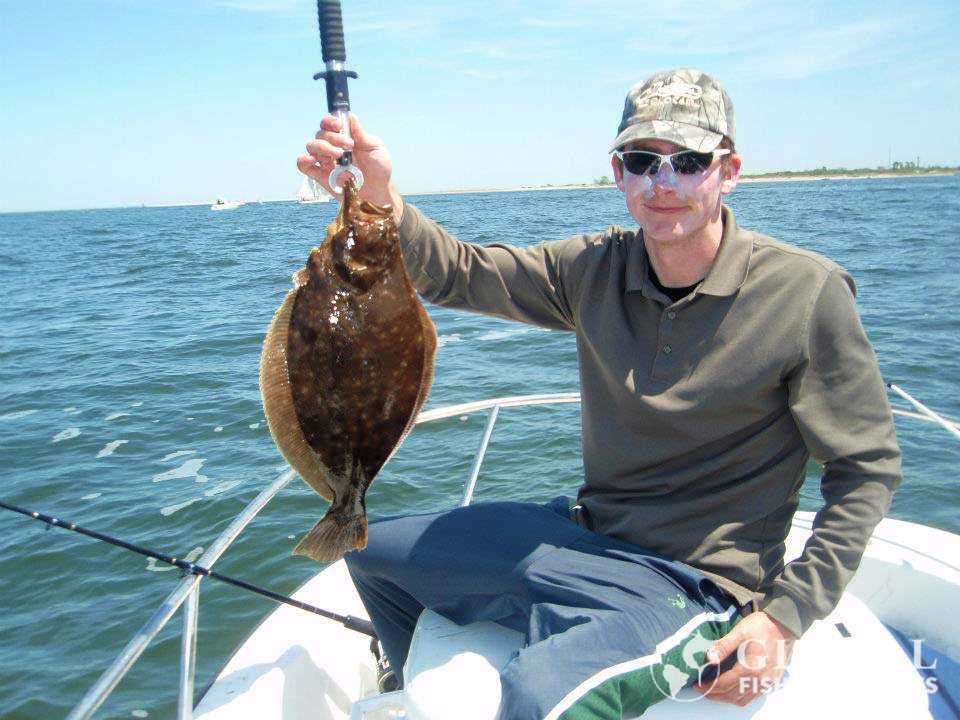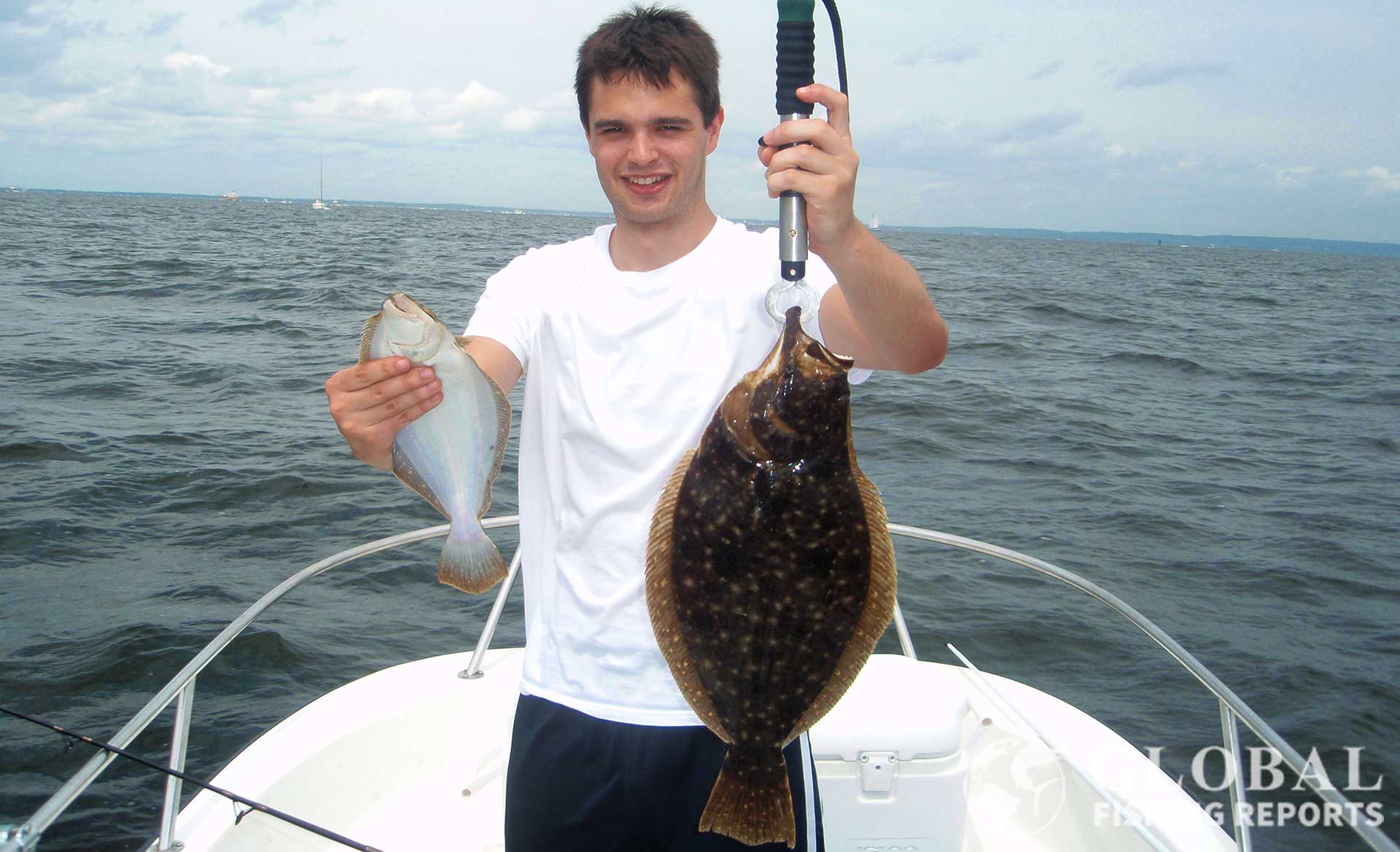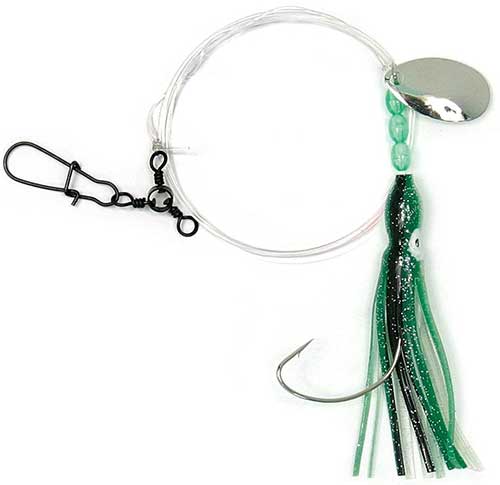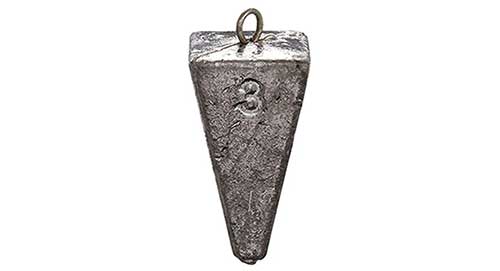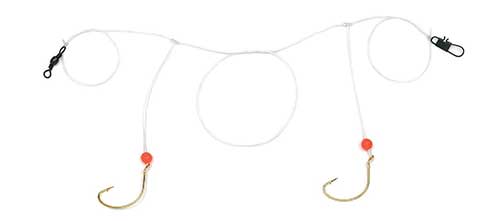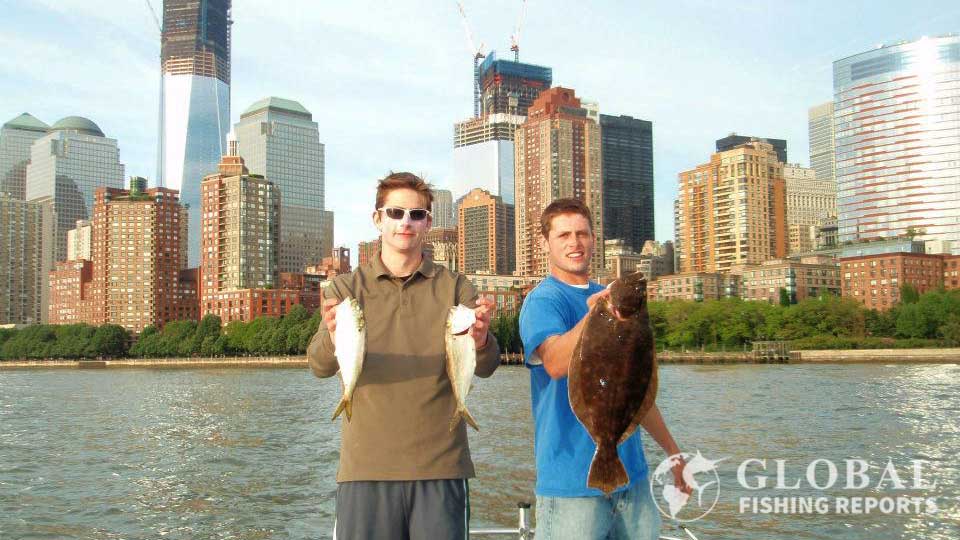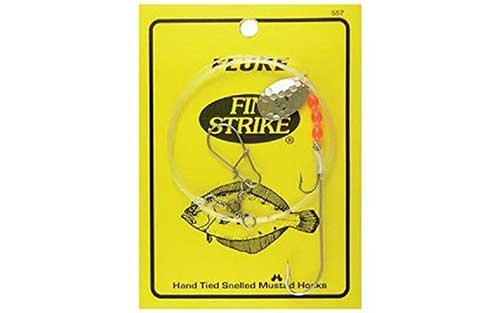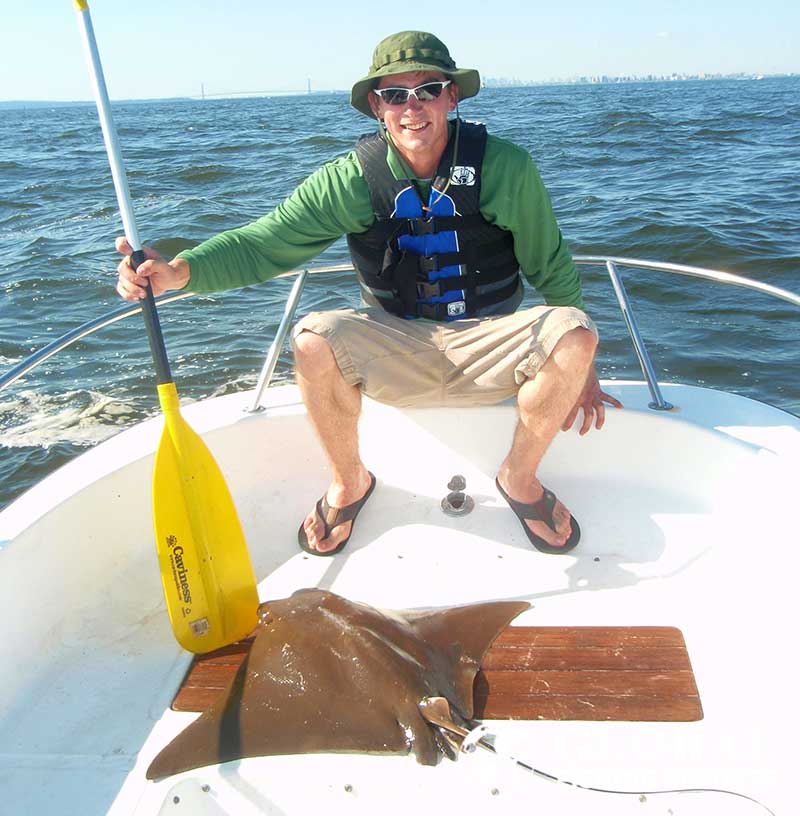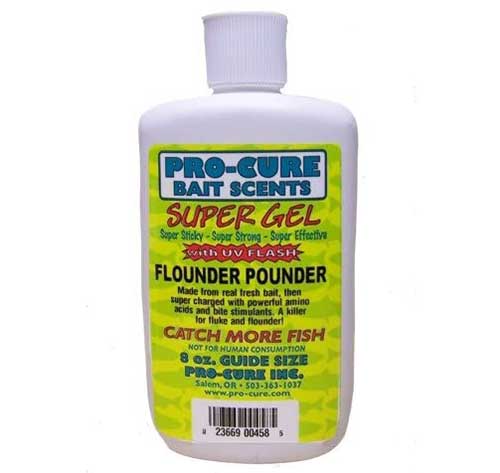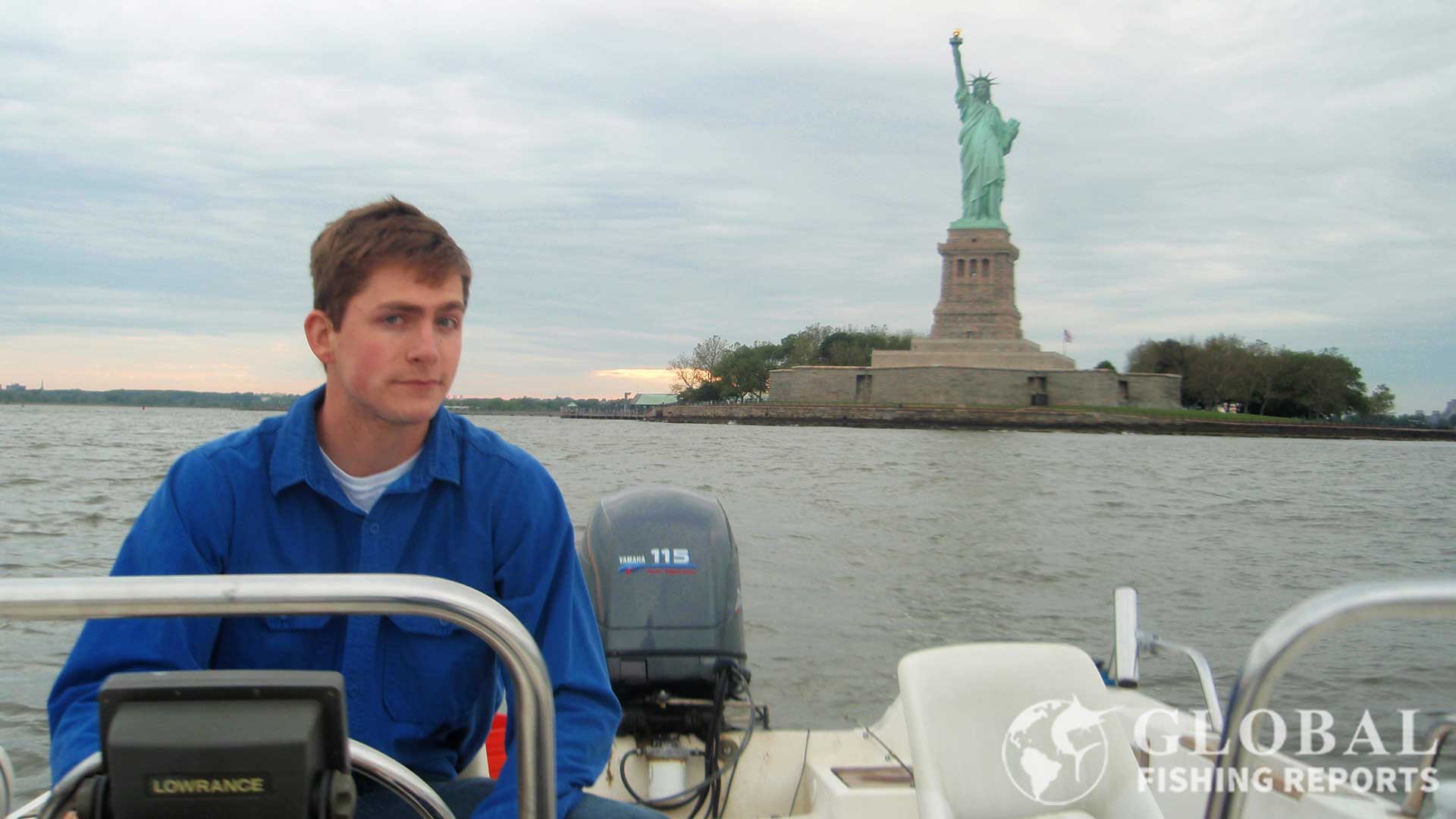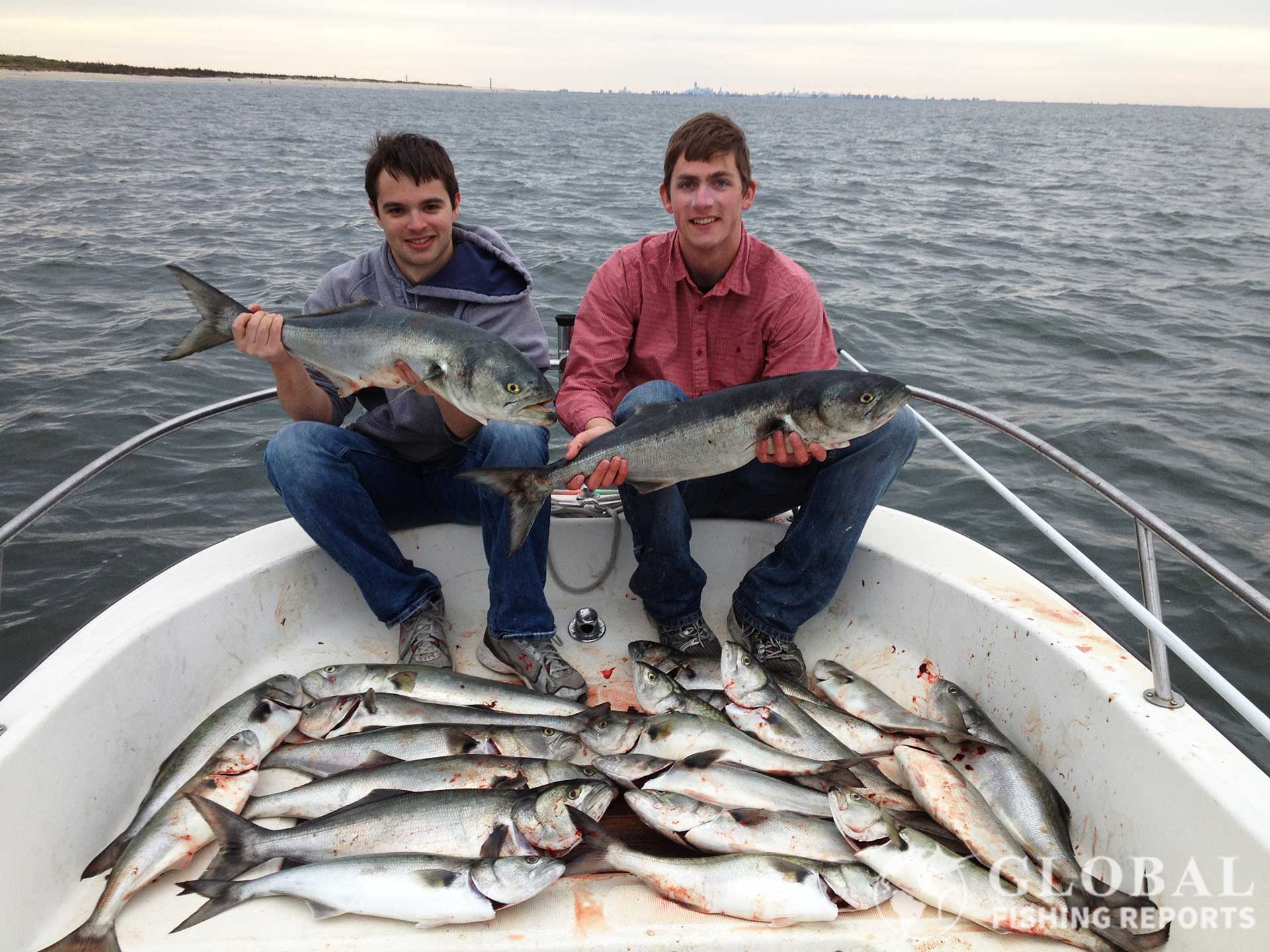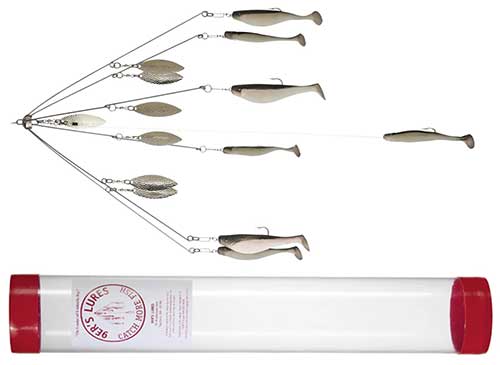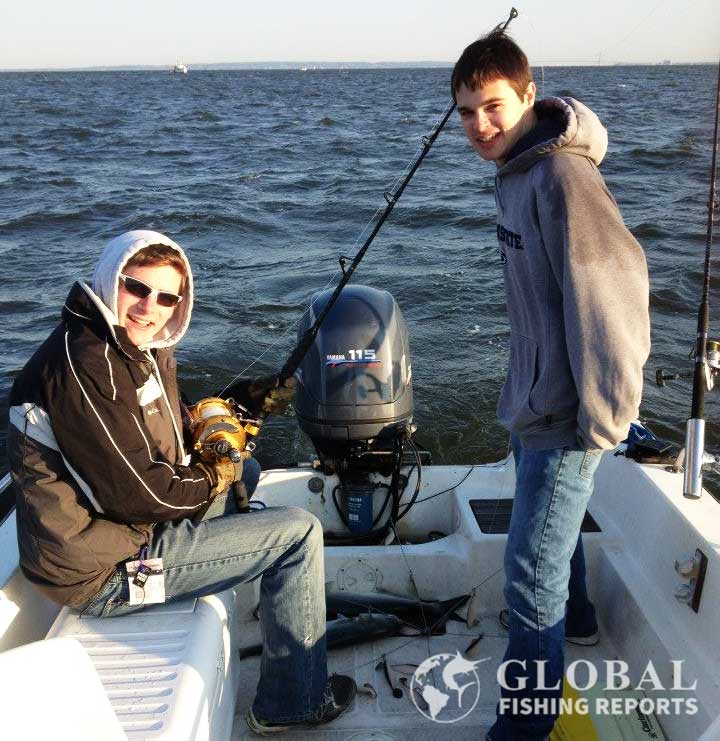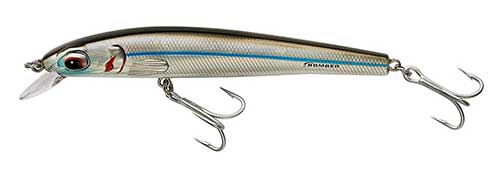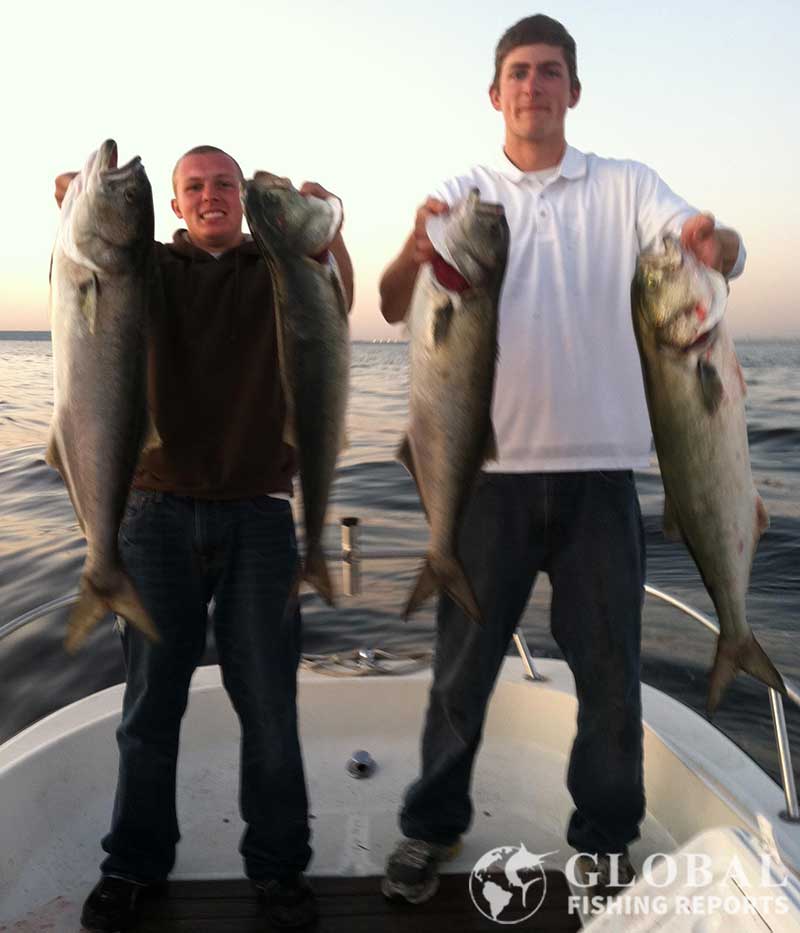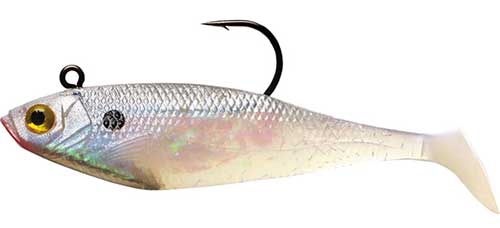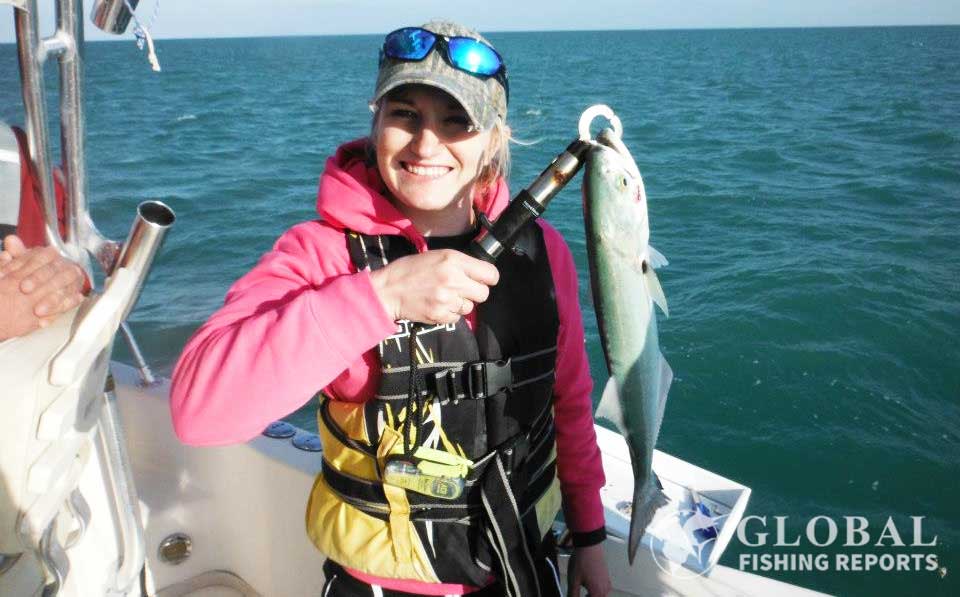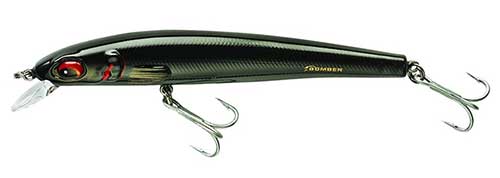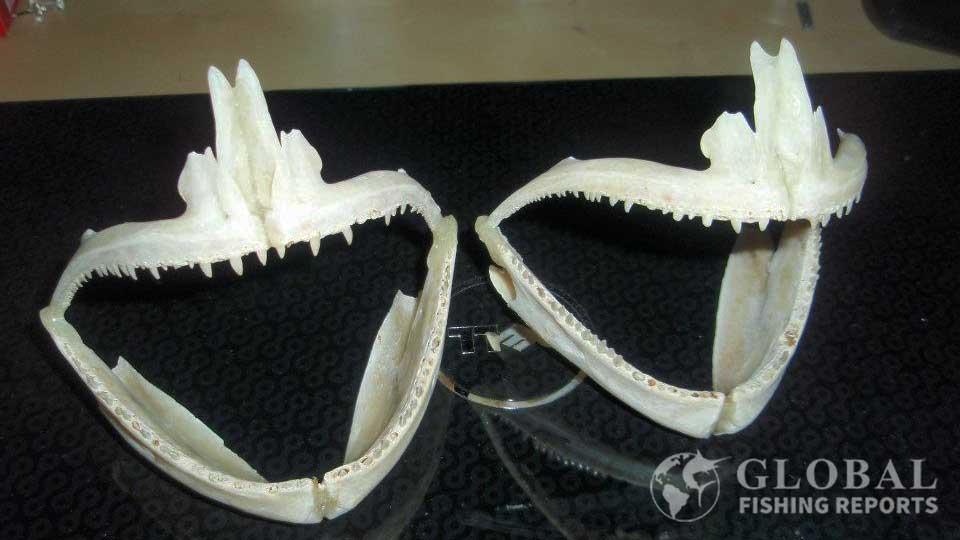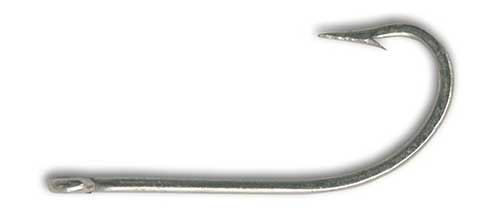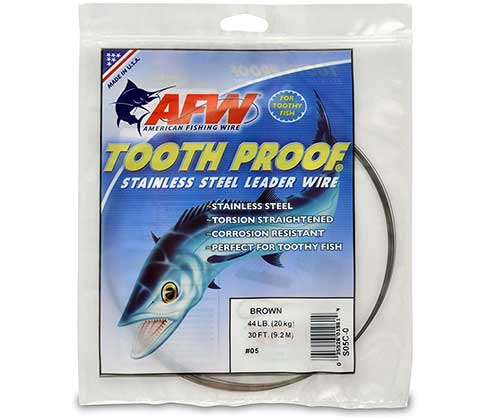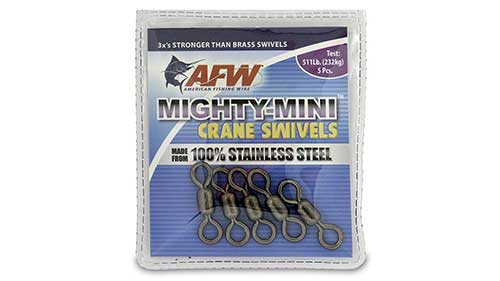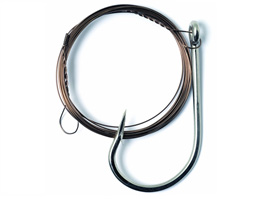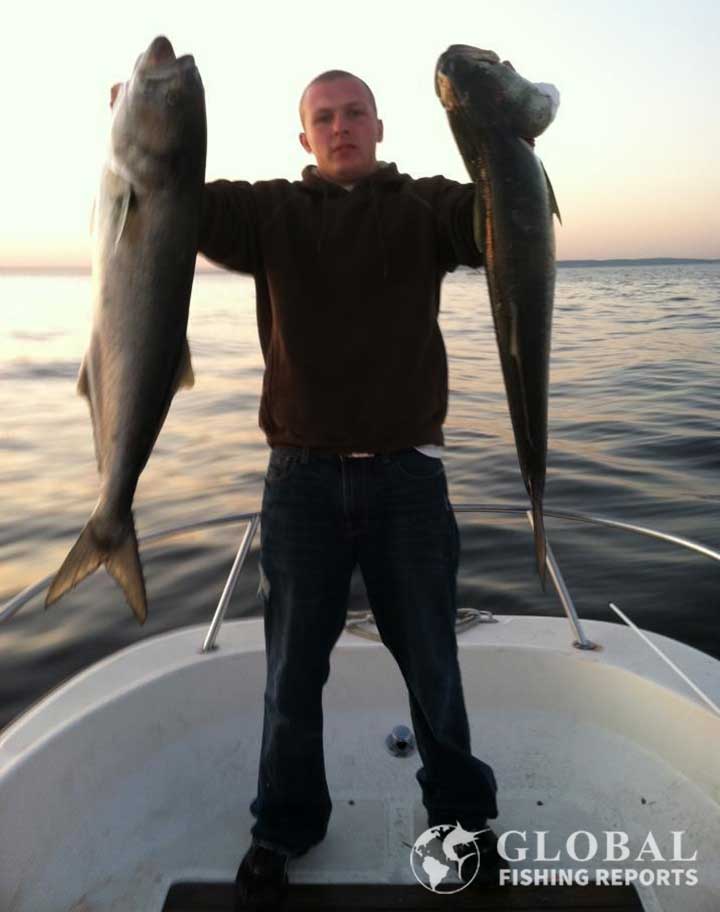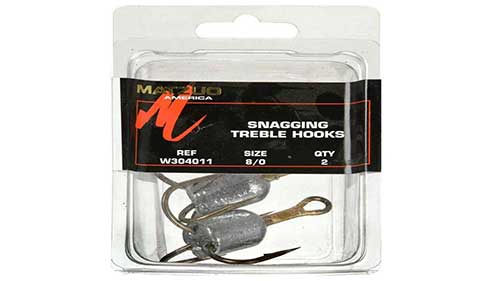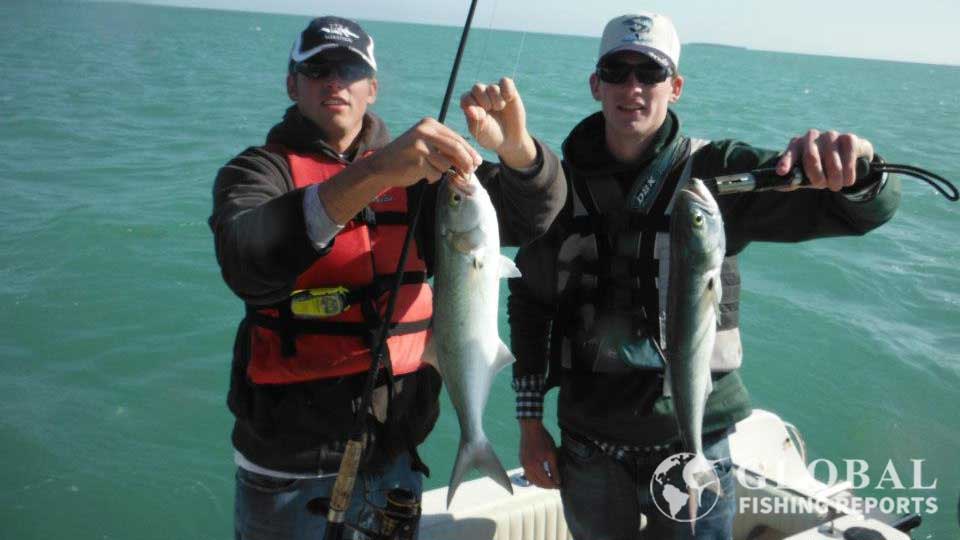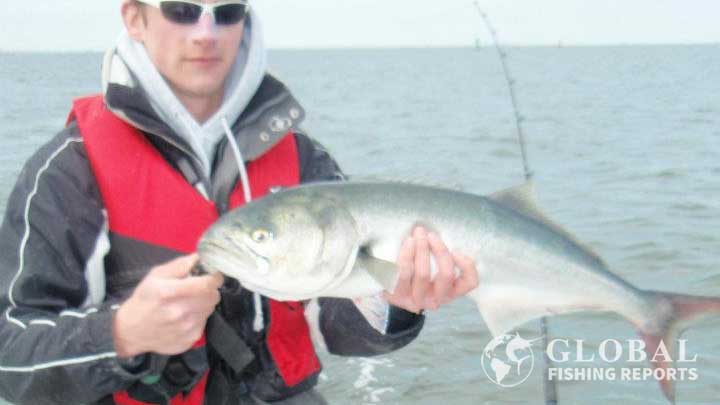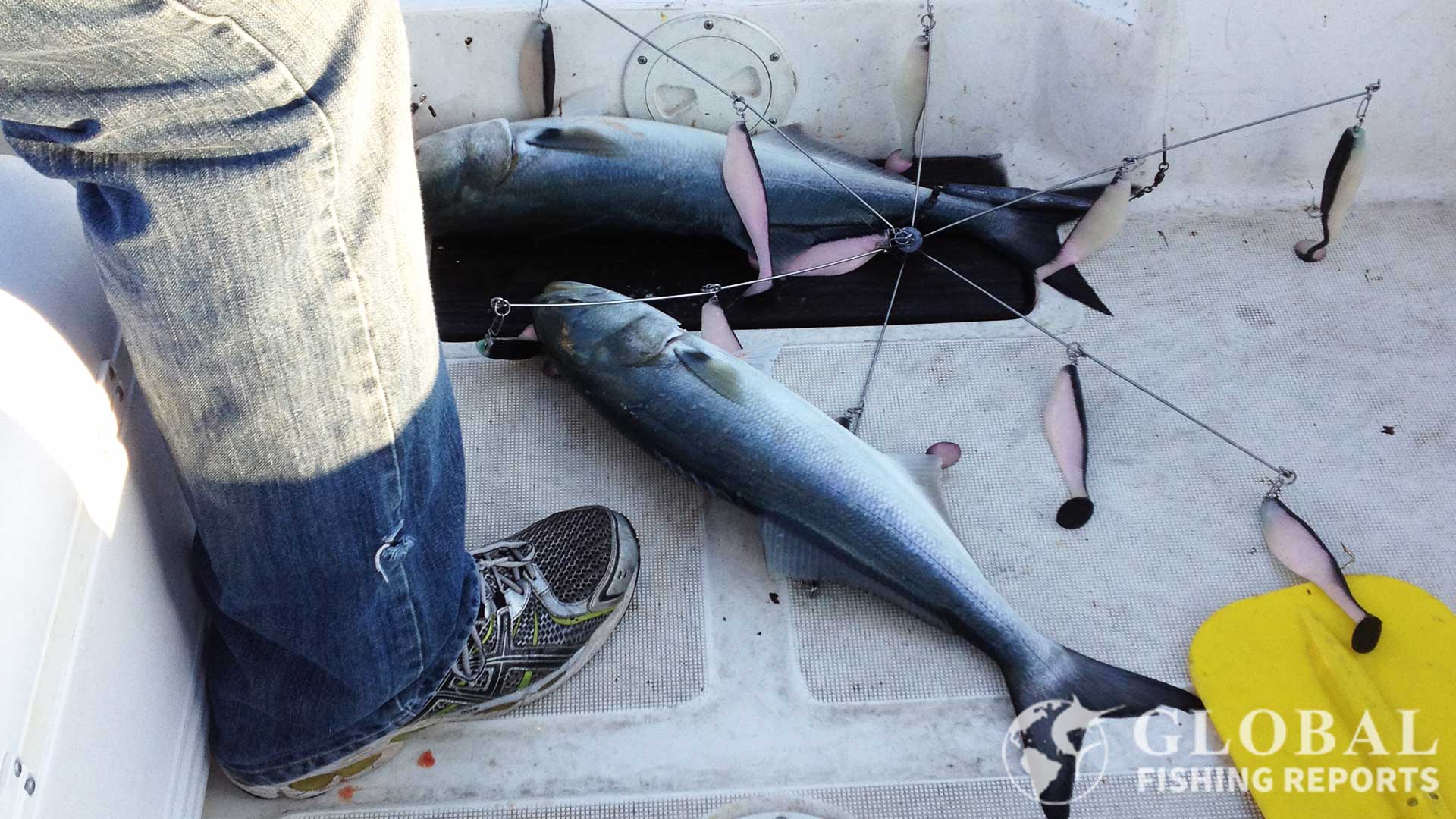I lived in New Jersey for four years and my favorite thing to do was fish for striped bass! There is a spring striper season and fall striper season. Lucky for people that love to fish for striped bass you can catch them day or night. When these fish are running it is honestly hard to find time to sleep.
You can fish for them from a boat or you can fish for them form the surf, jetty, rocks, riverbank, bridges, or piers. Often times you have to follow the bait to hunt them down. Knowing the best lures and baits for striped bass definitely gives you an advantage.
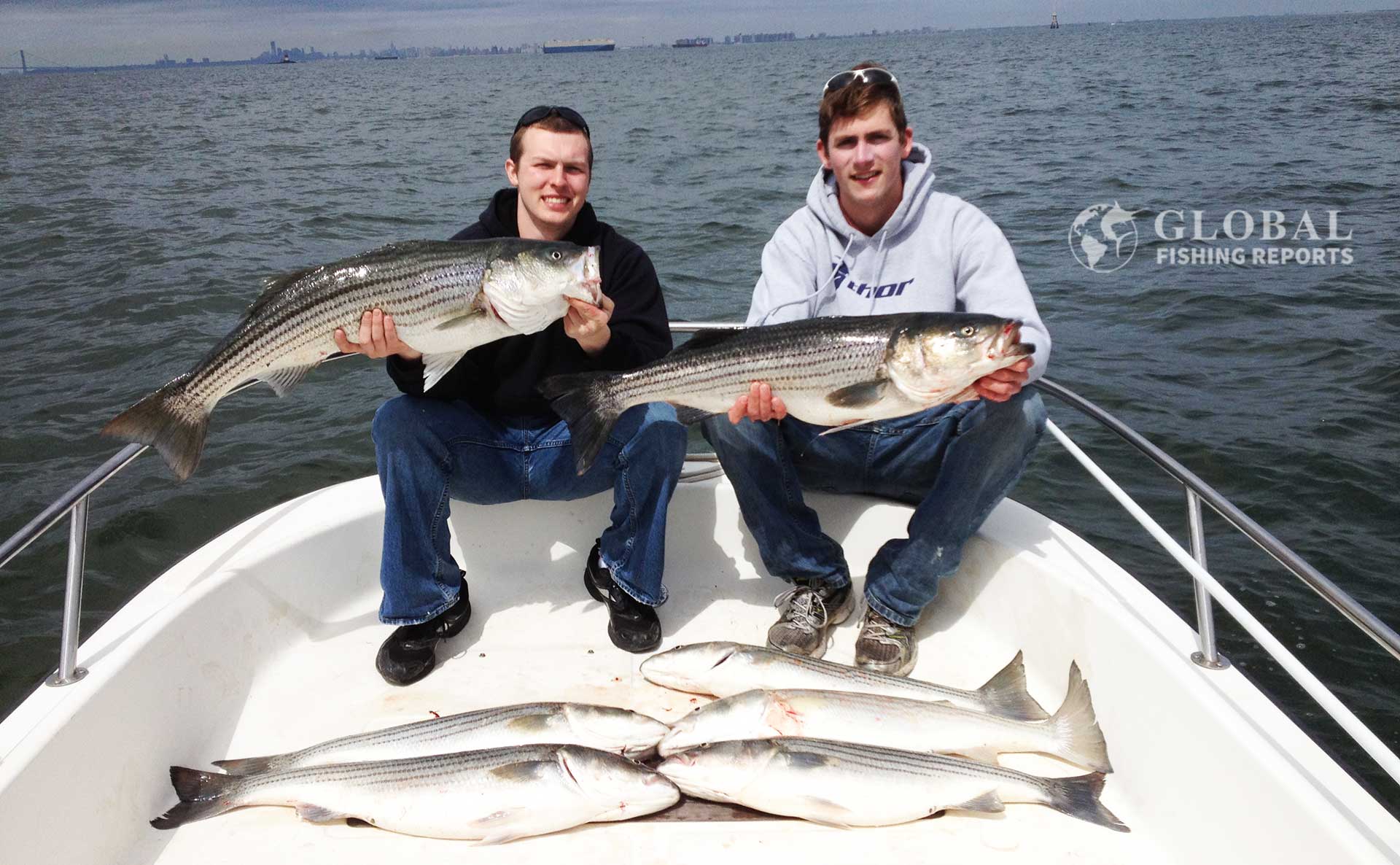
Where and When to Find Striped Bass
Striped bass are found in the nearshore waters of the North Atlantic Ocean. They’re in Virginia and Maryland in the wintertime and migrate North of New Jersey in the Summertime. There are also striped bass in the San Francisco Bay area in California in the spring.
Some striped bass stay year-round in all of these areas and are known as resident bass. The bigger striped bass migrate and spawn in rivers. Striped bass often follow baitfish such as bunker while they migrate. When striped bass are migrating in the spring and fall the beaches are lined with fishermen, the boat ramps are busy and it is game on for fishing. When fishing for striped bass it is also common to catch bluefish, weakfish, and fluke.
In this guide, I’ll show you my favorite striped bass lures and baits to use while trolling on a boat, drifting on a boat, and from the shore. Depending on where you find the striped bass will depend on what you want to use for bait.
Fishing Methods for Striped Bass
Trolling Rig: 9er’s New England Shad Umbrella Rig
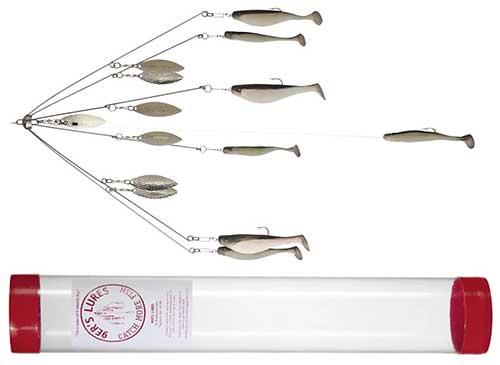
The 9er’s Lure New England Shad umbrella rig has 7 paddle-tail shad with hooks and 7 silver spinner blades. Shad color options include pearl black-back, chartreuse blue-back, and pear blue-back. A clear plastic storage tube comes with the rig which is extremely helpful.
This rig has 6 arms and a center stinger with a strong monofilament leader which has a 30-inch length. It is recommended to troll this rig with a 30 class or larger conventional reel. A braided line works well with a 50-100 pound test line. Multiple stripers can be caught at the same time. Trolling two of these at different depths is a great way to fish for striped bass.
When trolling umbrella rigs it’s almost hard not to catch striped bass. When the striper are in season there are typically lots of boats fishing in a general area off the beach. If you troll umbrella rigs in that area you should catch some striped bass. Look for schools of the bunker to troll around and also look for clam boats. Do not get to close to clam boats but they are fishing on clam beds which is also where stripers hang out. I troll slowly for bass between 2-3.5 knots.

Trolling Rig: Custom Four Arm Umbrella Rig
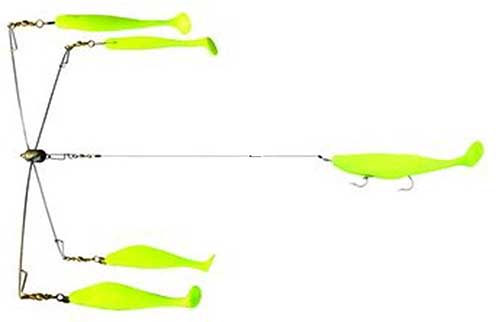
This Blue Water Candy is a four-arm umbrella rig with a center stinger swim shad. Only the singer bait has a hook. Blue Water candy also makes a Striperbrella with skirts over the swim shad. Color options are chartreuse and chaser white. There are also tube umbrella rigs that work well when bass are feeding on sand eels.
The most consistent way I know to catch striped bass is to troll with umbrella rigs. Trolling along the beach helps find out where the fish are hanging out. There are many different color swim shad that are used. It is a good idea to buy extra shad bodies because the bluefish tend to tear them up. These 4 arms umbrella rigs catch fish and can be run on smaller reels than the large 9-arm rigs. The Penn 80 in the picture below is larger than needed but is what I had at the time.
Trolling Weight for Umbrella Rigs

A 16-32 ounce pencil trolling weight can be clipped on to the front of the umbrella rig. This helps keep the rigs deeper in the water. I would recommend running two umbrella rigs one weighted and one not weighted and see which one starts catching fish and then put both of them at the depth that is catching the most fish.
The weight will get the rig deep in the water column at slow speeds. Be careful with the amount of line let out as this controls the depth of the umbrella rig. If too much line is let out the rig can hit the bottom and get snagged. I caught a huge fluke while trolling for striped bass which meant the rig was really close to the bottom!
The video below shows how to catch striped bass using umbrella rigs.
Bunker spoons are also a very popular way to troll for striped bass. Wire-line is typically used with 300 feet of line set out to get the spoon down 30 feet. Letting more line out should get them a little bit deeper but there is a limit. Some anglers use a bunker spoon with an 8-ounce mojo or bucktail jig to get the spoons deeper. This is done by placing the jig on a separate 6-foot braided line connected to a separate barrel swivel placed in front of a 15-foot monofilament leader for the bunker spoon. Bass can then bite one the jig or the spoon. Heavy jigs, plugs, and spoons can also be trolled along with bunker spoons and umbrella rigs.
Trolling Spoon: Tony Maja Custom Bunker Spoon

The Tony Mahi Bunker Spoons are used when trolling for striped bass. These come in sizes of 6-inch 6 ounces, 6.5-inch 8.5 ounces, 7.5-inch 9 ounces, and 8-inch 15 ounces. Color options are green, multi, white, and chrome. Bunker spoon are typically run with wireline. The spoons are set out about 300 feet to get down 30 feet. This is a 10 to 1 ratio to get the lure to the desired depth.
These spoons are made of stainless steel and are very durable. The small size works well when there are herring around. When full-size bunker are around the large 8-inch spoon is a good option. These spoons have a gentle weaving action that imitates an injured baitfish. The single hook on the lure is a nice feature as many striped bass that are caught are released.
Jigging Techniques for Striped Bass
Jigging is a great way to catch striped bass. While drifting or trolling it is important to keep an eye on the fish finder for structure or fish hanging near the bottom. Four-ounce jigs are good for fishing in less than 60 feet of water and 8-ounce jigs are good for fishing up to about 150 feet of water. When anchoring up and fishing with clams and bunker the motion of a jig near the bottom can be beneficial.
Swim jigs work well in shallow water as they can be cast and retrieved like a lure or allowed to slowly flutter all the way to the bottom. Eel jigs can be very effective around rocky jetties and fishing piers. Tandem mojo jigs and daisy chain jigs have become very popular in recent years. Why only have one swim shad when you can have 2-4 bodies to help attract the attention of nearby fish.
Swim Jig: Tsunami Shad
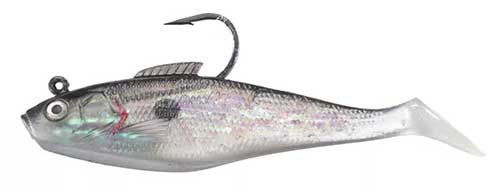
The Tsunami swim shad is a versatile bait for striped bass fishing. It can be trolled, jigged, or cast to go where the fish are located. This jig comes in size options of 3-inch 3/8 ounce, 4-inch 1 once, 5-inch 1-3/8 ounce, 6-inch 2-3/8 ounce, 6-1/2 inch 4-1/4 ounce, 7-inch 3 ounces, and 9-inch 6-1/4 ounce.
Features include 3D eyes, durable soft-vinyl body, Mustad hooks, and ultra-realistic foil core. Color options are purple haze clear, pearl spot, sea trout, white, chartreuse, mullet black back, limetruse, redfish, blue back, and golden bunker with spots. All of these colors work well depending on the conditions.
On bright days and clear water white and chartreuse are good colors. In low light or stained water the mullet black back is a good option. Matching the size jig with the baitfish the bass are eating is also important. Don’t be afraid to use a big jig.
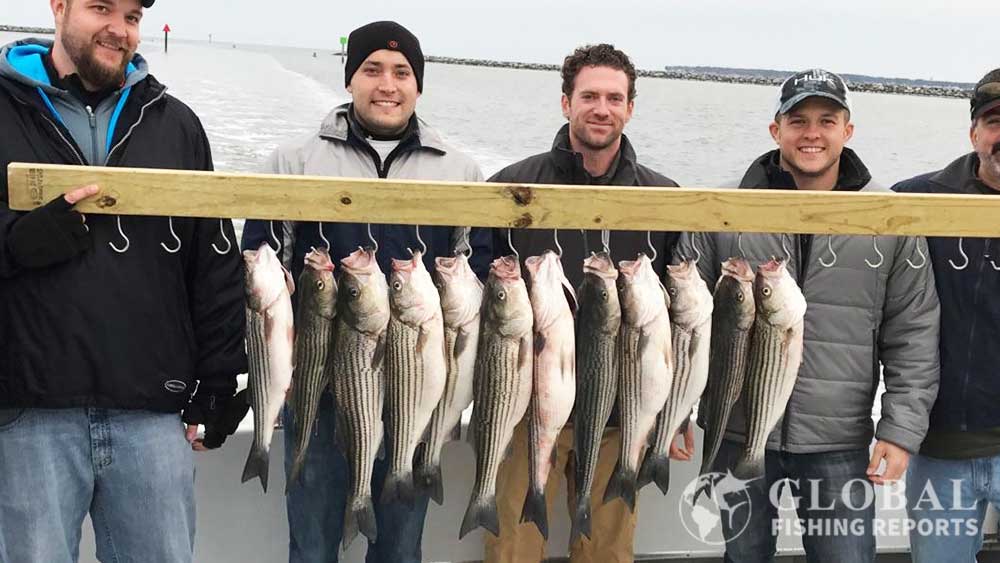
Swim Jig: Storm Shad
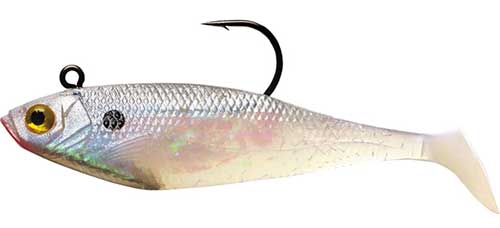
These Storm Swim Shad come in sizes of 3-inch .25 ounce, 4-inch .4375 ounce, 5-inch .625 ounce, and 6-inch .875 ounce. The 3-inch is good if the bait in the area is small and the 6-inch is good when there are schools of bunker are around.
Swimbait jigs work great for striped bass. These baits look a lot like a bunker and can be easily fished at any depth. The swim shad is a jig and has a weight in the head of the fish. These come in a variety of colors and patterns. These Storm Shad are lighter than the Tsunami Swim Shad which are better for gigging. A 5-inch swim shad is a common size to use but the three-inch size is better if small baitfish are in the area.
Swim Jig: Mojo Tandem Jigs
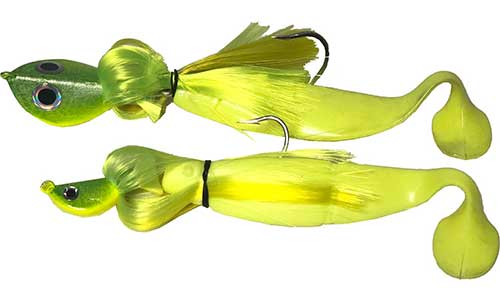
These are amazing jigs and are very similar to the style used by many charter captains. The jigs have an 8 ounce and 4 ounce parachute jigs in tandem. The skirt is made of nylon and mylar. The shad swimbait body is 9 inches long. These jigs come in chartreuse, black, white, and a pink pearl. All of these are great colors.
These are great jigs by themselves but this setup comes as a tandem rig so that two baits can be fished on a sinlge pole. I have not ever actually fish with the two jig set up like this but it seems like a great idea. Blue Water Candy also make a daisy chain swimbait lure setup with three shad bodies in front of a 12-ounce mojo jig.
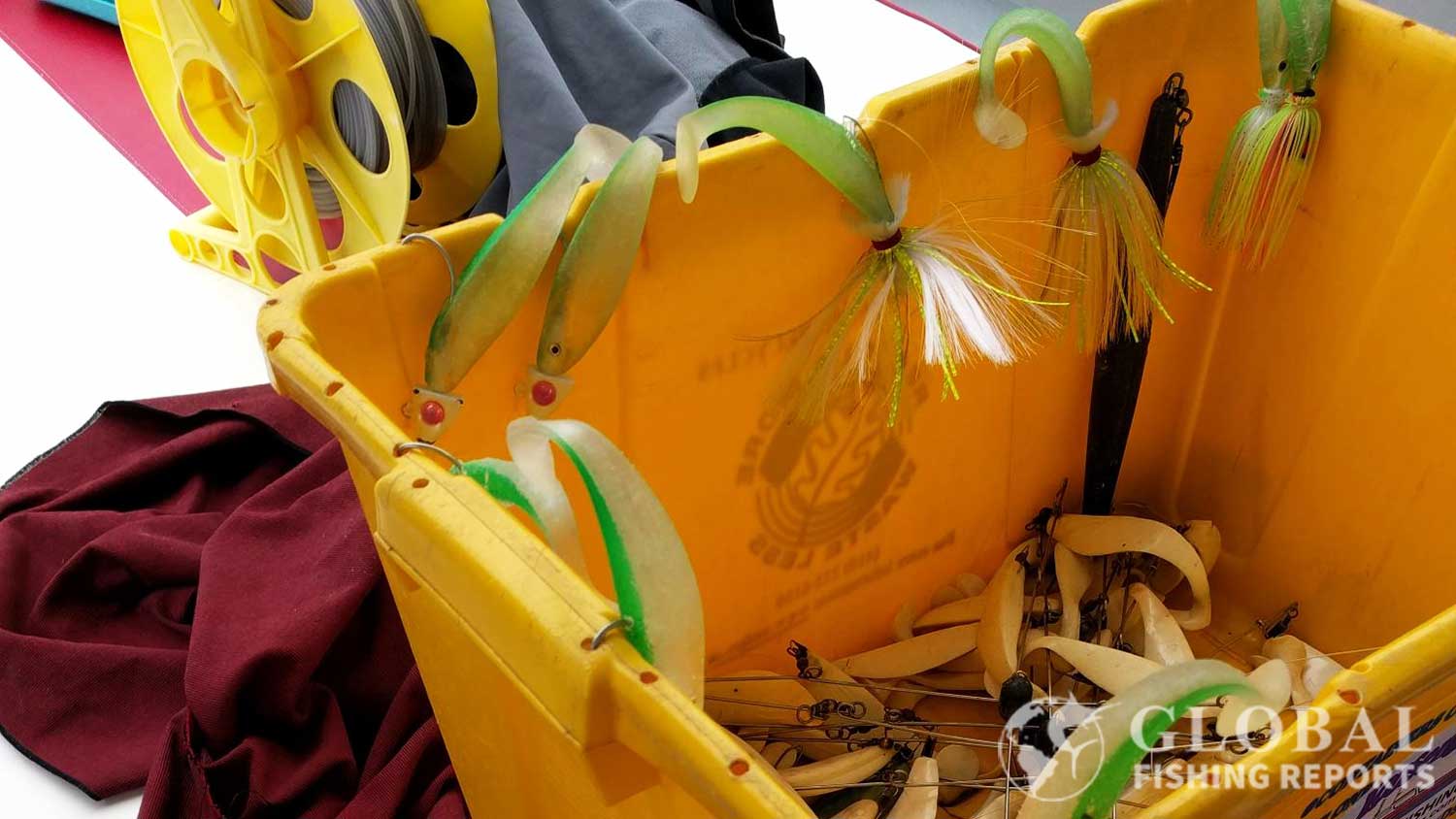
The video below shows how to troll with Mojo Jigs.
Swim Jig: Mojo Daisy Chain Lure
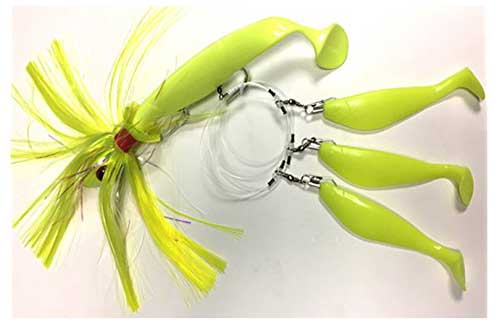
The Blue Water Candy Rockfish Candy is a daisy chain with a 9-inch jig that weighs 12 ounces. There are three daisy chain shads that are 6-inches in length. Color options include black, chartreuse, and white. There is also a 16-ounce, 24-ounce, and 32-ounce version of this daisy chain. The lure comes rigged and ready to go.
I think this 12-ounce Mojo daisy chain is one of the ultimate striped bass lures. It can be trolled with a conventional reel similar to umbrella rigs or jigged with a spinning reel. The nylon fiber skirt on the jig is a great addition that is commonly used by charter captains that jig for striped bass.
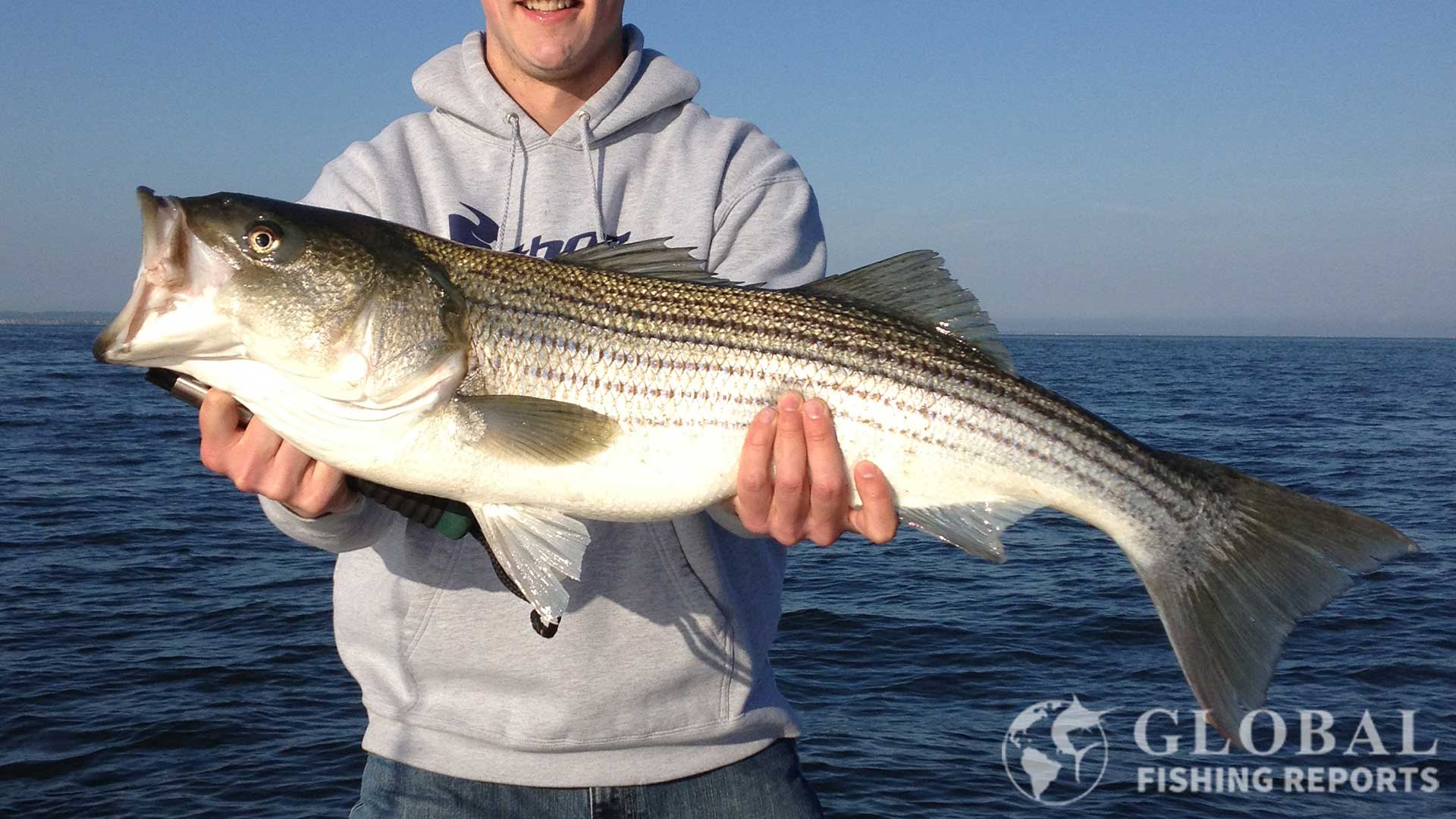
Swim Jig: Real Eel by Savage Gear

The Okuma Fishing tackle Savage Gear Real Eel comes rigged with a top J-hook and a treble hook on the bottom of the jig. This jig comes in two sizes a 12 inch 2-3/4 ounce eel and a 16 inch 5-3/4 ounce eel. The color options include blue black-pearl and olive black-pearl.
Eels are one of striped bass’s favorite food. This is the best imitation eel that I know of on the market. The large curly tail has great action even when retrieved slowly. This jig is heavy enough to slowly go deep and large enough to get the attention of any striper the sees the bait.
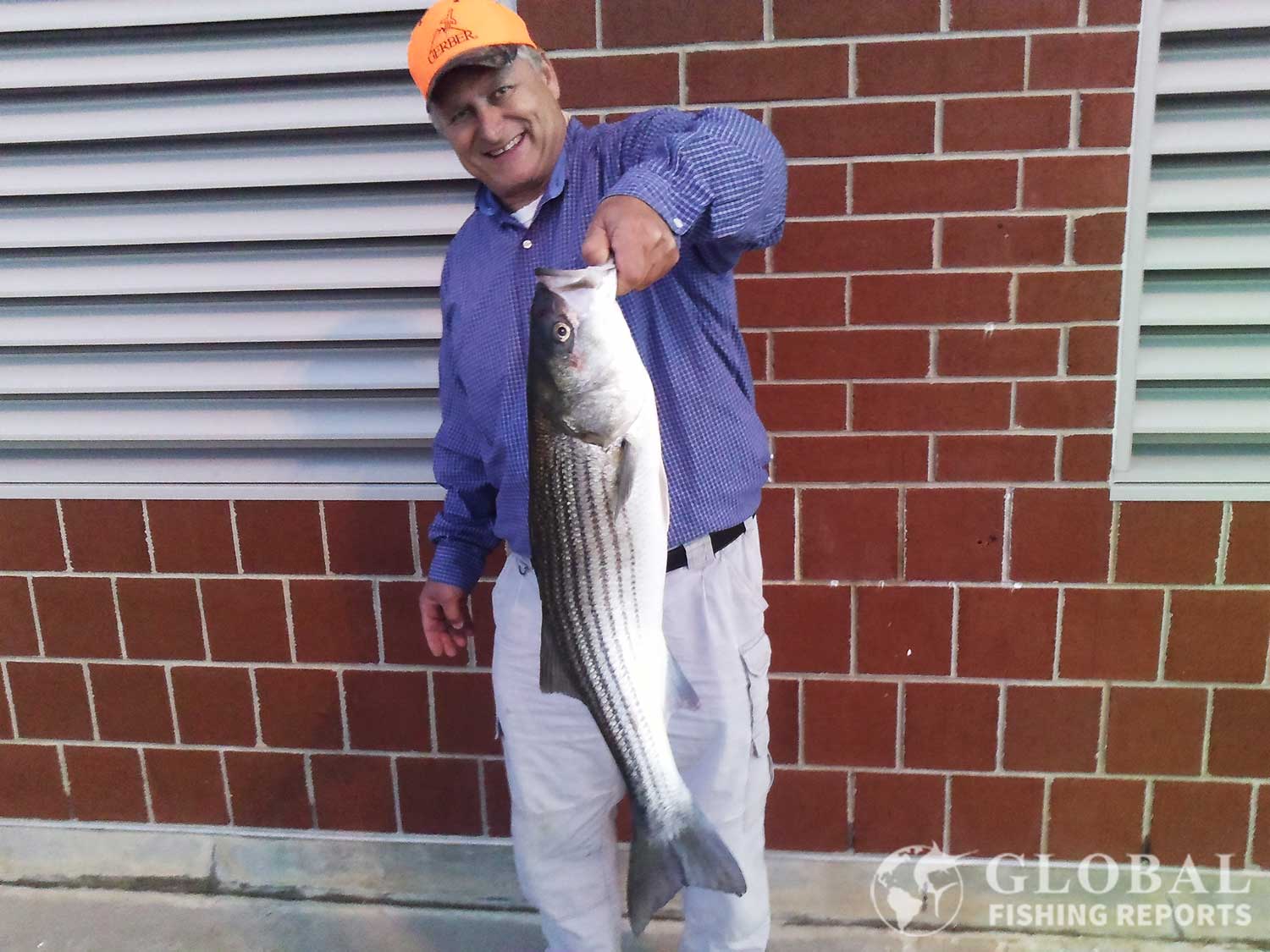
My dad caught the striped bass above on a pier in New Jersey. He brought a few live eels which I did not think were going to work at all. He cast out a weightless eel hooked through the nose a caught the striped bass on the first cast. I was very surprised! He also had a bite on every eel after that until we ran out of eels. I have had luck at the pier with jigs, bunker, clams, and bombers but never thought to try live eels. Every trip is a little different so it is good if you can figure out what the bass are feeding on that day. Sometimes it is blood worms other times it is little shrimp, sand eels, or spearing minnows. Try and match the bait to what the striped bass are feeding on at the moment.
Bucktail Jig: Bomber Bucktail Eel

The Bomber Jig-N-Eel is a popular jig made specifically for striped bass. It comes in 1-1/2 ounce and 3 ounces sizes. Color options are chartreuse, yellow, and white. All of the options have a bucktail and PVC eel body. Features include a hand-tied collar, triple-coated head, and saltwater hook. This jig works the best jigging near the bottom and along rocky jetties.
Bucktail Jig: Spro Bucktail
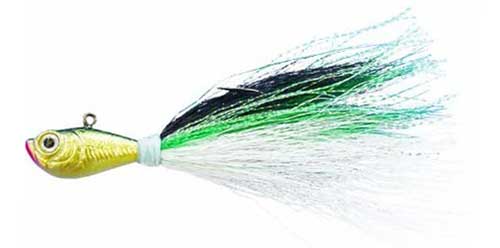
The Spro Bucktail is a top-quality jig used for striped bass fishing. It can be fished with or without adding a gulp curly tail bait. These come in weights of 1/4 ounce, 1/2 ounce, 3/4 ounce, 1-ounce, 2-ounce, 3-ounce, 4-ounce, and 5.5-ounce. The best weight depends on the fishing depth. Four ounces is good for less than 60 feet and the 5.5 ounce size works well for depths greater than 60 feet. For fluke fishing 4-ounce bucktails are typically used.
Color options include white, yellow, pink, sand eel green, blue shad, bunker, chartreuse, crazy chartreuse, dark shad, green shad, magic bus, mullet, spearing blue, and red-white. Bucktails are typically jigged near the bottom but also check for fish higher up in the water column on the fish finder. Features of the jig include 3D eyes, holographic finish, and super-sharp Gamakatsu hooks.
Jig: Ronz Lures Green Eel

This Ronz Big Game Jig is made to catch big fish. It is 10 inches in length and weighs 4 ounces. The jig is rigged on a power swivel jig eye with an ultra-sharp Owner long-shank ballyhoo hook. This jig is designed to catch big tuna and is strong enough to catch the largest striped bass. It can be trolled or jigged. The lure color is green glow.
There are other Ronz jigs available in 4-inch, 6-inch, and 8-inch sizes. Color options are orange fluorescent, silver metallic, white pear, olive metallic, and pink fluorescent. These are expensive jigs but are of high quality.
Jig: Tsunami Holographic Sand Eel

The Tsunami holographic sand eel is a great jig for striped bass. What anglers call a sand eel are long slender fish and are also called sand lace and needlefish. These baits work well for catching most types of fish including striped bass. Features include 3D body, durable soft-vinyl body, and black metal hooks.
Size options are 6 inches 3/4 ounce, 7-inch 1 ounce, 8-inch 1-1/5 ounce, and 9-inch 2-1/2 ounce. Color options are black-back and olive-back. Typically it is good to have the heavy jig sizes to get down near the bottom where sand eels are commonly found.
Surf Fishing for Striped Bass
Surf fishing for striped bass is a popular way to catch bass. This can be done from any shoreline. The most common rig has a circle hook tied to a fluorocarbon leader which is tied to a barrel swivel. Above the barrel swivel is a slider that has a clip for a pyramid lead weight. Bait such as clams, fresh bunker, eels, or bloodworms are placed onto the hook. The rig is cast out far from shore and then anglers wait for the striped bass to find the bait. The surf rod can be placed in a surf fishing rod holder and the anglers can then relax and enjoy the day. To make the fishing time more productive it is common to fish three rods at different distances from shore.
While shore fishing it is important to look for bird and fish surface activity. Schools of bunker fish might be active somewhere else along the beach. It is always a good idea to fish near the bait if possible. If there is surface activity is it good to have a heavy plug, surface popper, spoon, or jig to cast near the bait. A surf rig can still work but sometimes you have to follow the bait up and down the shoreline. It is also common to catch bluefish near schools of bait.
Surf Lure: The Long A Magnum Bomber

The Long A Magnum Bomber is a 7 inch 1.5-ounce plug that is great for surf fishing or trolling. Color options include black, chrome black, fire river minnow, mother of pearl, purple black-black, silver flash black-back, silver flash blue-back, silver flash chartreuse-back, silver flash green-back, and sliver flash red-head. This lure is rated for saltwater use.
The Magnum Bomer suspends at about two feet when casting and five feet when trolling. The lure pictured is the classic school bus Bomber color patterned that is very popular among surf fishing anglers. This is a large heavy bait that can be cast far out to where the action is off the beach.

Night Lure: The Long Shot Minnow Black Bomber

The Long Shot Minnow Bomber is more slender than the Magnum Bomber. It comes in sizes of 5-inch 3/4 ounce, 6-inch 13/16 ounce, and 7-inch 1-3/4 ounce. This plug dives about two feet when casting and five feet when trolling. Color options include baby bluefish, baby bunker, black, blue mackerel, bone, chartreuse herring, green mackerel, menhaden, mother of pearl, pearl yellow, and silver mullet.
The black Bomber is a great color to use for nighttime or low light fishing conditions. Silver mullet is a good color to use during the day in bright conditions. In green stained water green mullet or menhaden will match the water color well.
Surf Lure: Cotton Cordell Pencil Popper Striped Bass Lure

The Cotton Cordell pencil popper is another classic striped bass lure. It comes in sizes of 6-inch 1 ounce and 7-inch 2 ounces. Color options are the pearl red-head, bone, chrome blue-back, and chrome black-back. This is a topwater bait that is slowly retrieved while popping the lure. This is great for surf fishing or for when this is surface action when fishing from a boat.
Below is s video of anglers surf fishing with topwater lures for striped bass in Montauk New York.
Surface Lure: Tsunami Talkin Pencil Surface Popper
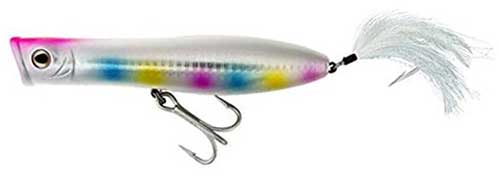
The Tsunami Talkin Pencil Popper is a large topwater bait. It is 6 inches in length and weighs 2.3 ounces. Color options are striped pearl, bone, smokey joe, clear ghost, bunker, silver-green, and green mackerel. The hooks are a 4X VMC treble hooks and a Siwash tail hook. This is a great lure for surf fishing as its heavyweight allows it to be cast a far distance from shore.
Surface Lure: Chug’N Spook Topwater Lure

This red and white Chug’N Spook is a 5-inch 1-ounce topwater lure. This lure has a rattle and front nose scoop that makes a popping sound. This lure is great for surf fishing when small and medium-sized striped bass are swimming through and breaking on bait. Many people fish this walk the dog style but it also works as a popper to look like an injured fish which helps to get the attention of striped bass in the area.
Surface Lure: Yo-Zuri Mag Darter Floating Diver

This Yo-Zuri Mag Dater is 6-1/2 inches in length and weighs 2 ounces. There are also 5-inch 1-ounce and 4-1/8 inch 5/8-ounce sizes. Color options are pearl chartreuse, pearl red-head, sardine, mullet, green mackerel, ghost black, candy, bone, bronze, and bronze shiner. The 2-ounce version is good for surf fishing as it casts a far distance.
Features of this lure include 3X treble hooks, ABS resin material, through-wire constriction, and a patented weight transfer system. This is not a topwater bait but runs a shallow 3-4 feet depth during the retrieve. The bait floats but the slanted front face allows the bait to submerge into the water. While swimming the bait darts from side to side and rolls like an injured baitfish. The video below provides more information about the Mag Darter.
Casting Lure: Sebile Magic Swimmer Slow Sinking Bait
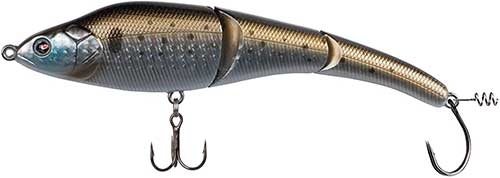
The Sebile Magic Swimmer has a fish-like appearance and jointed body for life-like action. This bait is 6-1/2 inches long, weighs 1-1/2 ounces, and is slow-sinking. There are also floating and fast-sinking versions in sizes from 3-3/4 inches 3/8 ounce to 9-inches 5 ounces.
Color options are bunker, fire tiger gold, ghostescent, green mackerel, holo greenie, and natural golden shiner. Bunker is a great color option for striped bass. This baits jointed design with a forward buoyancy allows the bait to have a natural swimming action. The magic swimmer is now on its second generation with better hardware and a reinforced body. There is a corkscrew on the back of the bait to add a teaser tail. The video below provides more information about the Majic Swimmer.
Spoon: Deadly Dick

The Deadly Dick is a spoon-like lure that is commonly used for striped bass and bluefish. This lure comes sizes of 2-1/2 inch .6 ounce, 3-3/8 inch 1.2 ounces, 3-7/8 1.6 ounces, 4-1/4 inch 2 ounces, 4-inch 4 ounces, and 5-inch 5 ounces. Color options are silver, blue, green, and red.
The lure can be fished by casting and retrieving. It can also be cast and allowed to sink like a vertical jig and then retrieved. This allows for the entire water column to be fishing. The lure is a good imitation of sand eels, squid, and spearing. These lures are rigged with strong split rings, strong crane swivels, and Mustad treble hooks. Having a small and large version of the lure can come in handy depending on the fishing conditions.
The video below is of anglers surf fishing for stripers in New Jersey in the fall. Sand eels are around and Deadly Dicks and Kastmaster spoons with tube tails are the lures of choice. The anglers are using surf fishing reels.
Spoon: Acme Kastmaster Spoon

The Kastmaster is similar to a spoon and works well for striped bass and bluefish. Size options are 1/4 ounce, 1/2 ounce, 3/4 ounce, 1 ounce, 1-1/2 ounces, and 2 ounces. There are over 30 color patters available for this lure with chrome, chrome-neon blue, and chrome-neon green being the most common to use for striped bass. Kastmasters also come in versions with bucktails and tube tails.
This lure can be cast and retrieved quickly or allowed to sink deep and then retrieved. The 2-ounce version can be cast a far distance from the shore when surf-fishing. If fish are high in the water column this lure can also be trolled.
Surf Fishing Rig with Bait

The classic surf fishing rig is used with live bait or cut bait. A surf rig is often called a slider rig because the weight is attached to the clip on the blue sliders shown above. The slider is above a barrel swivel on the line and the barrel swivel is tied to a four-foot leader with a circle hook. Surf fishing reels with long surf fishing rods allow these rigs to be cast out around 100 yards.
Striped Bass Surf Weights

A 3 oz pyramid sinker will work well in most situations. The pyramid sinker is important if there is a strong current. If there is no current a smaller sliding egg sinker on the line works well. It is important to have different size sinkers to be able to adjust the weight based on the current and preferred casting distance. Up to 6-ounce sinkers can be used when surf fishing.
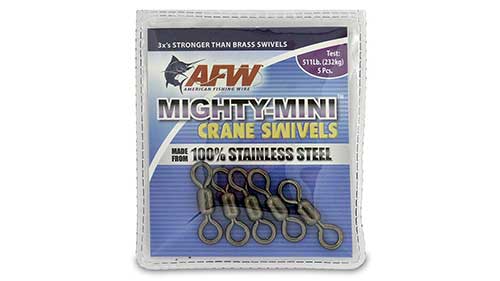
AFW mighty crane swivels can be used to attach the rig to the mainline.
Striped Bass Surf Rig Hooks
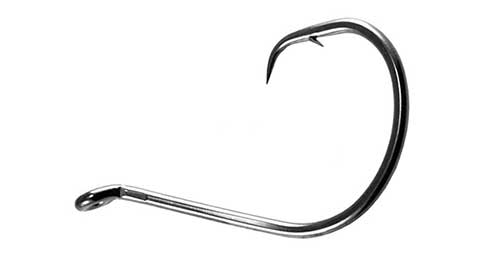
An 8/0 circle hook is perfect for your average size striped bass. Once the fishing line is cast out the weight sinks to the bottom and an additional line can be let out. The bait will then drift away from the pyramid sinker that is anchored on the bottom. If too much additional line is let out the bait might get tangled and it can be difficult to set the hook when a fish bites. When fishing on the bottom for striped bass it is also common to catch fluke.
The video below shows how to surf fish for striped bass.
Fishing Live Bunker Bait
If you made it this far you must really want to catch striped bass so I will tell you my favorite bait for striped bass which is a live bunker. All the lures above work great but if I had my choice I would pick a live bunker. Sometimes the bunker is so thick you can walk across them and it is easy to net or snag fresh bait. Other days there are not any bunker around. When there is some but not a ton of bunker around is when fishing with bunker works best. Finding a school of bunker that is being chased by predator fish is ideal.
Striped Bass Circle Hooks

Circle hooks are required by law in many locations and these hooks are a great way to catch and release striped bass safely. Size 7/0 or 8/0 is great when fishing for medium strippers. When bigger striped bass are around in the spring a 10/0 size hook is a good idea.
Striped Bass Fluorocarbon Leader
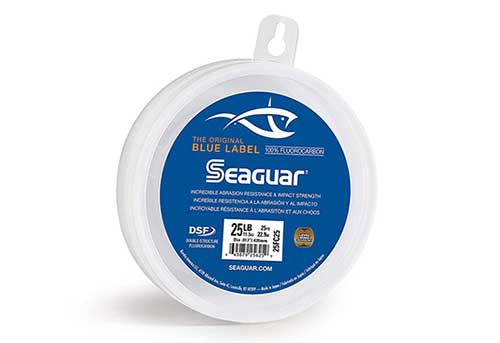
If the pole is set up with a braided line a fluorocarbon leader is needed. A 50lb leader with a 50-pound braided line is a good setup. Seaguar is a top-quality leader line but is also expensive. Any type or fluorocarbon leader line is better than a braided line and will work. Tying the braided line to the leader line is best achieved with a line-to-line double uni knot. There are other line-to-line knot tying methods but the double uni knot is the easiest to tie. If you do not know how to tie two lines together a barrel or cane swivel works to attach the leader.
A bunker is my favorite but any bait will work on the hook. Typical fresh baits for striped bass include chunks of bunker, clams, bloodworms, herring, mackerel, and eels. These have different levels of success depending on what the bass are feeding on in the area and the time of year. A circle hook works well with all of these baits.
Snagging Rig to Catch Bait for Striped Bass
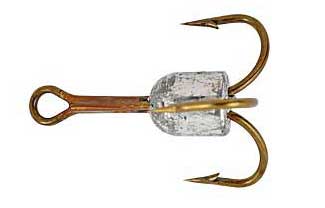
As mentioned above there are two ways to catch bunker which are a snagging rig or a cast net. Using a snagging rig the bunker can be snagged and fished immediately for striped bass using the treble hooks as the fishing hook. The bunker can also be reeled in and then set back out on a circle hook. Snagging a bunker and then letting it sink is the best way to fish with bunker as there are often striped bass under the bunker. If you let the bunker sink after snagging it there is a good chance a striped bass or bluefish will take the bait.
Catch Bunker with a Cast Net for Striped Bass Fishing
The second way to catch live bait is with a cast net. Below I show a video catching bait with my dad and friend Ryan. To learn more about the best cast nest and how to throw them check out the cast net page.
One important thing to mention is that any fish used as cut bait should have the scales removed first. My friend and I were fishing from a pier and kept having bass run and then spit the hook when using a cut piece of bunker. We were told that striped bass first scales a baitfish in a process that keeps the mouth of the striped bass open. If it is not scaled they will not clamp down hard to eat the bait and may spit it out of their mouth. If it is already scaled there is a better chance the fish will bite down and the circle hook will properly secure in the corner of the mouth.
Striped Bass Baitrunner Fishing Reels
Baitrunner spinning reels are typically used with striped bass so that poles can be left in holders while waiting for a fish to bite. For a circle hook, firm tension needs to be added to the line in order to hook the fish. The fish can always release the bait if it realizes something is wrong before tension is added. Try to quickly add tension to the line once it the fish starts running and the line is peeling off the reel. Of course remember not to set the hook when using a circle hook, just apply steady pressure.
Baits for Striped Bass
When fishing for striped bass it is best to try and match the bait they are naturally feeding on. The best baits include bunker, herring, mackerel, eels, clams, bloodworms, and sandworms. Striped bass feed on other baits such as sand eels, spearing, silversides, crabs, and grass shrimp that can be imitated with many different types of lures. At times striped bass feed aggressively and will bite any common bait. Other times they can be finicky and matching the exact bait they are eating is important.
Bait: Gulp Sandworm and Bloodworm Bait

Gulp sandworms are made to imitate live sandworms which are known to be a great striped bass bait. These come in sizes of 2 inches and 6 inches. Color options are motor oil, camouflage, natural, new penny, white, and bloody. These baits can be placed on a jig or with the bait on a hook similar to live bait fishing. This is a great bait to use around structure like rocks, ledges, pier piling, and bridge pilings that might be holding striped bass.
There is also Berkley Gulp Bloodworms. These are 6-inch scented baits that look like bloodworms. If you can get live bloodworms they make great baits and if not this is good alternative. These can also be fished on a jig or live bait setup.
Shrimp
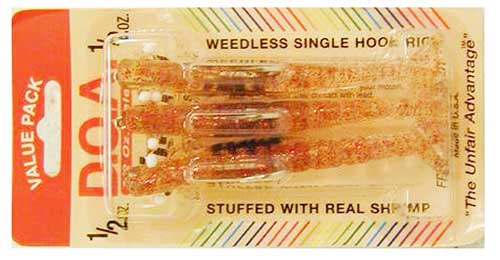
DOA Shrimp baits are known for catching all types of saltwater fish. Shrimp is a very common bait used in Florida but most anglers in the northeast do not use shrimp. There are various types of shrimp in the northeast including grass shrimp and northern shrimp.
This is a good bait to fish slow, like a soft plastic when fishing for largemouth bass. After the cast let it sink and then slowly retrieve the bait. The bait works well when fishing around rocky ledges, piers, bottom structures, or floating debris. This bait is also good to use at night around lights that are shining into the water.
Fly Fishing For Striped Bass
The picture above shows a striped bass that was caught on a fly at night. I noticed the bass were feeding on very small shrimp near a light and were not interested in any plugs or jigs that I was using. I took a treble hook off a lure that had a skirt and just used the hook and caught several striped bass with it.
This stopped working when all the whiskers from the skirt fell off the hook. When I got home I hand-tied two flies that caught the striped bass in the picture. This striped bass was caught from a pier at night.
Saltwater Fly
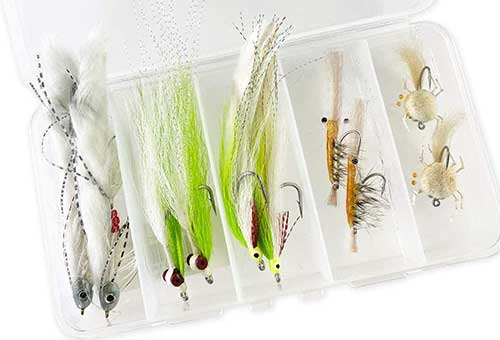
These Saltwater fly kits comes with a variety of saltwater flies. The Clouser kit has deep water deceivers that come in 5 different color patterns and two different sizes. While the World Wide Sportsman kit comes with 4 deep minnow flies.
Many anglers think of striped bass as predators that only eat bunker, eels, and clams. While striped bass do eat these baits they are opportunistic feeders that eat bait regardless of its size. If striped bass are feeding on grass shrimp on small minnows a fly can actually be the most productive bait.
Locating Bait and Striped Bass
Fishing Bunker Schools for Striped Bass
When fishing for striped bass it is very common to find schools of bunker. There are several options when you find the bunker. First look to see if the bunker are being chased by large predator fish. If so there is a very good chance that you are about to catch fish. Casting plugs, spoons, and jigs along the edges of the bunker school is one option.
A snagging rig can be used to hook a bunker, then open the bail and let it sink to the bottom. Sometimes striped bass and bluefish will eat the injured fish. If it does not catch a fish retrieve the bunker and keep it for bait. Snag another bunker and repeat this process. Make sure to fish all depths around the fish. It is common for the predator fish to be deep below the school of bait. If this does not work you can switch over to trolling around the bunker. If there is no activity around the bunker you can always throw a cast net to catch the bunker to use as bait elsewhere.
Pier and Bridge Fishing for Striped Bass
Pier fishing for striped bass can be very exciting and there are many fishing tactics that can be used. A great time to fish a pier or bridge is at night if there are lights that shine into the water. Baits such as eels and bloodworms are great to use. If you see bass or surface activity Bomber plugs are great to use. In deep areas swim jigs can be a good option. Using a bunker on a surf rig is a good way to catch striped bass near the bottom.
Another good thing about pier fishing is there are typically other types of fish to catch such as fluke, weakfish, sea bass, and bluefish. From a boat, bridge pilings can also be fished with live eels and heavy jigs.
Fishing for Striped Bass in Rivers
Striped bass are commonly found in rivers along the northeast from late April until the end of May. Popular rivers to fish for striped bass include the Hudson River in New York, Connecticut River, Chesapeake Bay tributaries, upper Delaware Bay, and the Delaware River. Striped bass can be caught in the river using jigs, plugs, baits such as live herring, cut bunker, sandworms, and bloodworms placed near the bottom.
Shore Fishing for Striped Bass
Shore fishing for Striped bass can be done for more areas than just a beach. Bridges, piers, jetties, inlets, and rocky shores are all great places to fish for striped bass. If the fish are not biting in one area explore some new areas and see what kind of fish activity is in the area. When there are baitfish in the area the striped bass and blues will not be far behind. Once the bait is found it is worth spending time in that area. If the fish are not biting a simple tide change could change the bite quickly.
Night Fishing for Striped Bass
My favorite lure to catch striped bass at night is a black Bomber. At night striped bass are often feeding near the surface and a dark lure near the surface stands out. If live bait can be caught, a baitfish on a float is another great choice. I have also caught striped bass on small flies and bloodworms at nighttime. It is important to be quiet and approach areas slowly when fishing at night. If you can find lights shining into the water that is a great place to fish. There are underwater lights that can be bought for nighttime fishing.
Seasonal Strategies for Striped Bass
Spring Fishing for Striped Bass
Striped bass spawn in the springtime and this brings in the big breading female bass. The bass migrate in the spring from the water around Virginia north to Massachusetts and Maine. For states like Maryland, New Jersey, and New York this is a great time to go fishing for striped bass. In Maryland, it is common to use bait and jigs for striped bass in the spring. In New Jersey and New York, schools of the bunker are the most common areas to target striped bass by either trolling or snagging bunker and letting them sink. Further north in Massachusetts and Maine, the striped bass are feeding on herring and mackerel.
Fall Fishing for Striped Bass
In the fall striped bass are commonly found along the shore and is a great time to surf fish for striped bass. All the typical baits and lures work for fall striped bass fishing. What becomes popular though is anchoring up and fishing clams. Clams are chummed and fished near the bottom. The striped bass are migrating in the fall from the northern waters of Maine and Massachusetts down to Virginia for the winter. There are some smaller resident striped bass that stay along the rocky shores of Maryland, New Jersey, and New York year-round.
Common Questions about Striped Bass Fishing
What is the difference between a striped bass and a rockfish?
In the Chesapeake Bay area, striped bass are also commonly called rockfish but are actually striped bass. There are over 130 different types of rockfish that are found in the northeast Pacific Ocean. When running fish charter in Alaska it is common to catch yelloweye rockfish, black rockfish, quillback rockfish, and dusky rockfish. These fish look more like grouper than striped bass.
How to catch freshwater striped bass?
In freshwater, there are white bass, hybrid striped bass, and actual striped bass. Some striped bass are hatchery fish but there are areas where freshwater striped bass spawn naturally. There needs to be a river area for spawning to take place. The fishing techniques for freshwater striped bass are very similar to saltwater striped bass. Baitfish and lures that match the bait in the lake should be used. It is common to use umbrella rigs, jigs, surface plugs, and live bait. Fishing can be done during the day or at night.
What are the best color lures for striped bass?
The best color lure for striped bass depends on the fishing conditions. When trolling umbrella rigs pearl white, chartreuse, and white body with a black-back are great colors. For swim jigs, white, chartreuse, and bunker imitation baits work well. For shallow running plugs black is a great choice at night. In the daytime, a yellow school bus color or redhead with a white body are good color options.
Is striped bass good to eat?
Yes, striped bass is considered a very good fish to eat. It is a firm white meat that can be grilled, pan-seared, blackened, or fried. Striped bass also makes good fish tacos.
What is the size limit for striped bass?
The size limit for striped bass varies depending on the date, and state the fish was caught in, and varies from year to year. It is common for there to be a slot size limit for striped bass for example over 28 inches but less than 35 inches. This allows the larger breeder fish to stay in the population when letting anglers keep average size fish to eat. Atlantic striped bass have long lifespans and can live up to 30 years. A striped bass that is 35 inches long is likely 10 years of age or older. For this reason, it is important not to keep too many large fish which could reduce striped bass numbers in future years.
Captain Cody has worked on charter fishing boats in the Florida Keys, Virgin Islands, and Alaska. Growing up in Pennsylvania Cody has also done extensive freshwater fishing including bass fishing tournaments. Cody strives to provide detailed information about the best fishing gear and tactics to help both novice and experienced anglers have a more productive and enjoyable time on the water. Cody also has a background in aerospace engineering and neuroscience but really only takes pride in being good at one thing and that is fishing!

